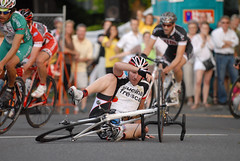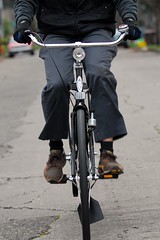
(Photo © J. Maus)
[This is our latest Bike Science column by Shawn Small. Read previous entries here.]
With cyclocross season in full swing and the rainy season upon us, it’s likely that tires have become a part of your bike gear conversations of late. And it’s no surprise; tires have a huge impact not just on the quality of your ride, but on whether you get home in one piece.
So let’s talk about tires.
Traction — the fundamental reason we have tires — is defined as “…a physical process in which a tangential force is transmitted across an interface between two bodies through dry friction or an intervening fluid film resulting in motion, stoppage or the transmission of power.” Or, put another way, it’s the frictional force that holds you and your bike to the ground.

The place where that frictional force happens is known as the contact patch.
When you sit on your bike the tires deform (squish) under your weight. This squish is also known as the contact patch. The area of the contact patch is equal to the weight load divided by the air pressure. While it seems counter-intuitive, here’s why big, fat, and wide tires roll better (explained by Schwalbe themselves, and yes, it has to do with contact patch):
“Because of the longer flattened area of the narrow tire, the wheel loses more of its “roundness” and produces more deformation during rotation. However, in the wide tire, the radial length of the flattened area is shorter, making the tire “rounder” and so it rolls better.”
And now for some homework: Here’s the formula to find out the area of your contact patch:
Where,
- A: is the area of the contact patch (inch2)
W: is the combined weight of the bike and the rider (lbs)
P: is the tire pressure (pounds/inch2)
For example, the combined weight of me and my bike is 200 lbs. and I run my tires at 90 psi. Therefore…
This equates to roughly 2.22 inch2 of total contact patch. Then divide that by 2 (two tires) and you have approximately 1.11 inch2 of tire contact patch per tire (Note: the rear tire sees approximately 60% of the total weight while the front sees approximately 40% during normal riding conditions this equates to a rear contact patch of 1.33 inch2 for the rear and 0.89 inch2 for the front tire).
Now that we’ve tackled contact patch, what about the tread pattern that is doing the contacting?
With all the rain we’re getting, have you ever thought you might hydroplane while riding through a puddle? While a tire tread pattern is important for cars to shed water to prevent hydroplaning, the same hydroplaning effects are not realistic for a bicycle due to the rounded tires and considerably higher tire pressure.
NASA (yes, NASA) has done testing to determine the critical speeds to hydroplane a vehicle. They found that it is primarily based upon the tire pressure and can be simplified by this equation. Where,
- V: critical speed in knots (1 knot = 1.15mph)
P: tire pressure (pounds/inch2)
A tire with a low pressure of 30 psi would require a speed of approximately 57 mph to hydroplane, and a tire at 90 psi would require a speed of approximately 98 mph. These speeds aren’t really attainable for a bicycle under normal conditions (Zoobombing notwithstanding).
Even with hydroplaning out of the question, have you ever wondered if the grooves and patterns on tires are really necessary? After all, some people get by with nearly 100% slick tires.
When it comes to bicycling, we’ve basically got two operating surfaces. Either the ground is hard and smoother than the inflated tire (e.g. pavement, concrete, etc.), or the ground is softer and bumpier than the inflated tire (e.g. sand, dirt, mud, etc.).
On smooth paved roads traction is generated primarily by the rubber compound of the tire. Softer rubber compounds tend to grip better and increase the traction for accelerating, turning, and braking. But softer tires comes with a cost — they don’t last as long and they are less puncture resistant.
On the road, slick or smooth tires provide better grip than ones with tread patterns or grooves. Why? Because a slick tire maximizes the contact patch surface area of the tire with the ground. The grooves or tread patterns on road tires are put on primarily for cosmetic reasons.
However, on soft, bumpy ground the tread pattern and grooves on the tire are crucial to increase the traction forces. When the ground is soft the tire knobs actually dig into the surface and interlock it — like a cog and a chain — providing an increase in traction and handling. The stiffer and harder the knobs are the more they dig into the ground, this is why metal studs work so well.
Now that you know a bit more about tires, the next time someone tells you to, “Keep the rubberside down!” you’ll have some science to help you do it.
Check out these links and PDFs to learn more:
-
— Tire pressure as a function of weight and tire size in an easy to read chart (PDF).
— NASA documentation on Phenomena of Pneumatic Tire Hydroplaning (PDF)
— Schwalbe has some interesting information related to their tires
— Website for ETRTO, the European Tyre and Rim Technical Organisation (These folks set tire and rim standards)
— Bike Science is sponsored by: Strava.com – GPS cycling, virtual competitions and detailed ride analysis.



